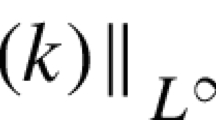Abstract
The weak-noise limit of Fokker-Planck models leads to a set of nonlinear Hamiltonian canonical equations. We show that the existence of a nonequilibrium potential in the weak-noise limit requires the existence of whiskered tori in the Hamiltonian system and, therefore, the complete integrability of the latter. A specific model is considered, where the Hamiltonian system in the weak-noise limit is not integrable. Two different perturbative solutions are constructed: the first solution describes analytically the breakdown of the whiskered tori due to the appearance of wild séparatrices; the second solution allows the analytic construction of an approximate nonequilibrium potential and an asymptotic expression for the probability density in the steady state.
Similar content being viewed by others
References
H. Haken,Synergetics, An Introduction, 2nd ed. (Springer, Berlin, 1978).
N. G. Van Kampen,Stochastic Processes in Physics and Chemistry (North-Holland, Amsterdam, 1981).
P. Hänggi and H. Thomas,Phys. Rep. 88:207 (1982).
C. W. Gardiner,Handbook of Stochastic Methods (Springer, Berlin, 1982).
H. Risken,The Fokker-Planck Equation (Springer, Berlin, 1983).
R. Graham and A. Schenzle,Phys. Rev. A 23:1302 (1981).
H. E. Schmidt, S. W. Koch, and H. Haug, preprint 1982.
D. Hellwig, thesis, Universität Essen (1982), unpublished.
E. Ben-Jacob, D. J. Bergman, B. J. Matkowsky, and Z. Schuss,Phys. Rev. A 26:2805 (1982).
A. D. Ventsel and M. I. Freidlin,Russ. Math. Surv. 25:1 (1970).
Ju. I. Kifer,Math. USSR Izv. 8:1083 (1974).
D. Ludwig,SIAM Rev. 17:605 (1975).
R. Graham, inFluctuations, Instabilities and Phase Transitions, T. Riste, ed. (Plenum, New York, 1975).
R. Graham and T. Tél,Phys. Rev. Lett. 52:9 (1984).
J. L. Lebowitz and P. G. Bergmann,Ann. Phys. (N.Y.) 1:1 (1957).
V. I. Arnold,Dokl. Akad. Nauk SSSR 156:9 (1964).
M. V. Berry, inTopics in Nonlinear Dynamics, S. Jorna, ed. American Institute of Physics Conference Proceedings, Vol. 46 (Am. Inst. Phys., New York, 1978), pp. 16–120.
R. Graham and A. Schenzle,Z. Phys. B 52:61 (1983).
I. S. Gradshteyn and I. M. Ryzhik,Table of Integrals, Series and Products (Academic Press, New York, 1965).
R. Graham and H. Haken,Z. Phys. 243:289 (1971);245:141 (1971).
Author information
Authors and Affiliations
Additional information
On leave from Institute for Theoretical Physics, Eötvös University, Budapest, Hungary.
Rights and permissions
About this article
Cite this article
Graham, R., Tél, T. On the weak-noise limit of Fokker-Planck models. J Stat Phys 35, 729–748 (1984). https://doi.org/10.1007/BF01010830
Received:
Issue Date:
DOI: https://doi.org/10.1007/BF01010830



